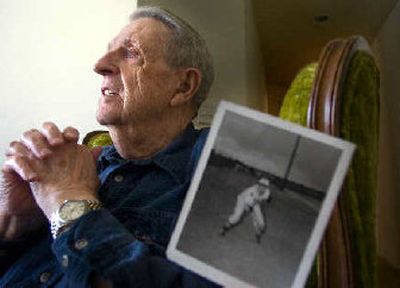Mementos hit auction block

Walter Johnson’s likeness is about to find a new home. So will a well-traveled baseball that carries on its skin the signatures of some of the game’s greatest pitchers.
Both objects are being auctioned by Spokane resident Bill Ogle, who became their owner 15 years ago after a favorite uncle died and passed them his way.
What they’ll fetch from baseball collectors is hard to say – possibly more than $15,000. The auction – managed by Chicago-based Mastro Auctions – closes around 7 p.m. Friday.
The baseball, which carries the signatures of seven 300-game winners, has current bids of nearly $2,400 on the Mastro Web site at www.mastronet.com. The 19-inch ceramic statue, created by prominent American sculptor Ulric Dunbar in 1924, has drawn bids of $6,600 so far. Ogle, who’s 82, hopes to see both items climb high enough that he comes away with at least $10,000 in profits. He’s paying a commission to the auction house, plus a fee to Jim Price, a Spokane baseball historian and former Spokesman-Review copy editor, who is helping to arrange the sale. Said Ogle: “I just hope whoever gets them really appreciates them. That’s important to me, because my uncle and my grandfather both worked hard to get them.”
His uncle, Sam Ogle, acquired the statue back in the late 1920s.
The ball originally belonged to Sam Ogle’s father, George Ogle, who acquired the first autograph on it – Walter Johnson’s – in 1924.
George and Sam Ogle lived in Wisconsin. The father passed the ball on to Sam Ogle, who carried on his father’s legacy by gathering names of players he met through clubs and collector’s groups.
In addition to Johnson’s, the other names on the ball include Hall of Famers Grover Alexander, Lefty Grove, Cy Young, Kid Nichols, Warren Spahn and Early Wynn.
Brian Marren, a consignment manager for Mastro Auctions, thinks the ball might sell for as high as $5,000 or $6,000.
The statue, however, is far more valuable and could go much higher, Marren said.
While Mastro Auctions see more money being spent lately on American art and antiques, some of its highest-value auctions are for sports balls, uniforms and memorabilia.
“Sports items are a very large market,” said Marren, noting that one of the firm’s highest-priced sports items was a baseball that sold for $90,000. It had the autographs of the 1927 New York Yankees – which some have called baseball’s best team.
Bill Ogle has lived in Spokane most of his life and retired in 1990 after running a Spokane Valley car dealership. He and his wife, Betty, who’s 82, have been lifelong baseball fans.
Ogle pitched for a minor league baseball team in Pueblo, Colo., while training to be a pilot during World War II.
“My uncle was a great athlete, too,” Ogle said. “He once pitched an 18-inning game, but lost 1-0.”
The baseball’s value has been diminished by its physical condition, being slightly scuffed and heavily shellacked, probably by Sam Ogle, said Price.
But its bigger flaw is that it also was signed by four other players who were not 300-game winners. Those players were asked by Sam Ogle to sign the ball, Price said.
“If it had nothing but 300-game winners, that ball would be far more valuable,” said Price.
Price researched the Johnson statue and learned it’s likely to be one of two identical pieces done by Dunbar, who was one of the East Coast’s most prominent sculptors in the early 20th century.
The sculpture was finished in 1924, right after Johnson helped the Washington Senators win the World Series. A Washington, D.C., newspaper article specifically mentions Dunbar’s plan to make the sculpture, Price found.
Dunbar sent both pieces to Judge Kenesaw Landis, the first major league baseball commissioner. Landis apparently didn’t want two copies and sent the second piece back to the artist.
Ogle said his uncle knew a Wisconsin state politician who was acquainted with Dunbar in Washington. “He arranged to get the statue and that’s how my uncle got it and took it to Wisconsin.”
The other statue, according to Price, was eventually donated to the Baseball Hall of Fame. “I called them,” said Price, “and all they would say is it was donated by a man who was living in Illinois.”